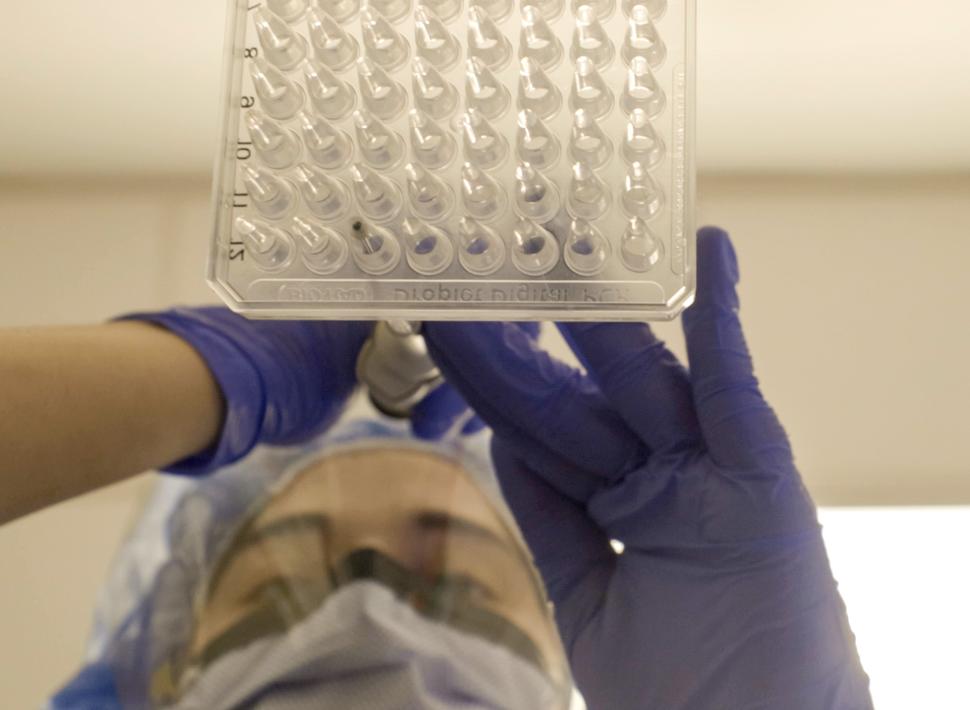Rapid Genetic Test Could Help Guide Brain Cancer Surgery
, by Edward Winstead
Scientists have developed a method of rapidly measuring the levels of certain genetic mutations in brain tissue samples collected from patients during surgery.
In a new study, researchers showed that the droplet digital polymerase chain reaction (ddPCR) method they developed could produce results in 15 minutes—the first time ddPCR has generated results so quickly.
Their tool accurately measured the levels of tumor cells in dozens of brain tissue samples, they reported. And it detected minute numbers of cancer cells, as few as five cells per square millimeter, according to findings published February 25 in Med.
The researchers developed the tool, which they call Ultra-Rapid ddPCR, to provide surgeons with information that could potentially help guide their decision-making during surgery.
“This new technology could be an additional source of information for a surgeon who is deciding whether to keep removing tissue during an operation,” said study co-leader Daniel Orringer, M.D., a neurosurgeon at NYU Grossman School of Medicine. “If the test detects tumor cells at a surgical margin, then surgeons could decide to keep cutting.”
Surgeons already make decisions based on many factors, such as whether removing a certain part of the brain would affect a person’s cognitive or physical abilities. The results of an Ultra-Rapid ddPCR test would be one more factor, Dr. Orringer noted.
In the NCI-supported study, they tested brain tissue samples for two mutations—IDH1 R132H and BRAF V600E—that are found in many brain tumors but aren't present in healthy brain cells.
The results from Ultra-Rapid ddPCR were as accurate as standard ddPCR, which also detects mutations but takes several hours and cannot be done while the patient is still in surgery.
“Speed is of the essence,” said study co-leader Gilad Evrony, M.D., Ph.D., a physician–scientist at NYU Grossman School of Medicine’s Center for Human Genetics and Genomics. “Our goal was to learn how we could do this testing as fast as possible while also producing accurate results.”
Making timely decisions during brain surgery
The new technology has the potential to assist surgeons “in making timely intraoperative decisions,” said Jing Wu, M.D., Ph.D., a clinical neuro-oncologist in NCI’s Neuro-Oncology Branch, who was not involved in the study.
“Understanding the mutation status of the IDH1 and BRAF genes can assist surgeons in determining different tumor resection strategies,” Dr. Wu added.
In addition to testing tissue for the presence or absence of specific genetic mutations, Ultra-Rapid ddPCR can be used to assess the density of tumor cells in a sample, especially at the margins of a tumor.
Surgeons might decide to stop removing tissue once the number of tumor cells per square millimeter in a sample drops below a certain level, such as below 10, 50, or 100 tumor cells per square millimeter, the researchers noted.
“We aim to remove a tumor in its entirety,” Dr. Orringer said. In cancers that have sharp, or clear, margins, he continued, it may be possible to do this. “But gliomas tend not to have sharp margins, and we need technology to help guide resection.”
Focusing on speed
The researchers developed Ultra-Rapid ddPCR by shortening the time required to complete each of the steps involved in standard ddPCR.
For example, they cut the time needed to extract DNA from brain tumor samples from 30 minutes to less than 5 minutes. They also increased the concentrations of certain chemicals used in the PCR process and increased the speed of cycle sampling between the different temperatures of PCR.
To confirm the accuracy of Ultra-Rapid ddPCR, the researchers performed both Ultra-Rapid ddPCR and standard ddPCR on more than 75 brain tissue samples from 22 patients who had undergone surgery for brain tumors.
The performance of Ultra-Rapid ddPCR matched that of standard ddPCR based on several measures, including the percentage of cells within a tissue sample that are cancer cells.
Making the technology faster and easier to use
The new approach, the researchers believe, could complement techniques that are currently used to help guide some surgeries, such as frozen sectioning. In that process, which can be done in 15 to 20 minutes, a tissue sample from a patient is rapidly frozen and then cut into sections and examined by a pathologist.
Image-based analytic tools, such as ultrasound and intraoperative MRI, can detect tumor margins and produce results quickly in the operating room, Dr. Orringer noted. But these tools have limitations because “tumor infiltration occurs on a microscopic scale, below the level of detection of existing tools” he said.
According to Dr. Wu, Ultra-Rapid ddPCR needs to be further refined before it can be used outside of clinical studies.
“This is a brand new technology, and we have not yet used it to actively guide brain tumor surgery,” Dr. Evrony said.
As a next step, the researchers plan to automate the process to make it faster and easier to use in the operating room. They will then conduct a clinical trial to see whether the new approach helps guide surgeons and benefits patients.
“We’re optimistic that this study is a starting point for the field to develop even faster technologies for [identifying genetic mutations] in the operating room,” Dr. Orringer said.
Dr. Evrony added, “We hope our technology and future methods will make molecular-genetic information rapidly available in the operating room for many types of cancers.”
